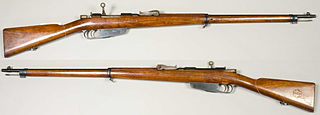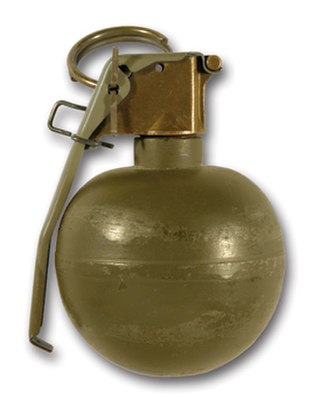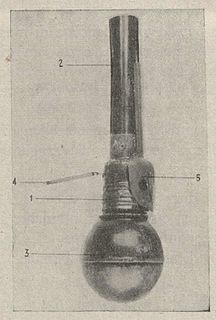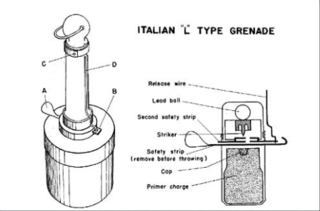History
In the 1970s and 1980s it became necessary to replace the SRCM Mod. 35, which dated back to World War II. A first model of the new grenade, the OD / 82-HE with its training version OD / 82-E-1, was produced by the company "La Precisa S.p.A." Teano. [1]
Adopted by the Army, production was immediately interrupted after numerous incidents (some fatal) of premature detonation. The grenade was then modified by the Italian's army "Stabilimento Militare di Munizionamento Terrestre" (S.M.M.T.) of Baiano di Spoleto and was adopted by the armed forces as OD 82 / SE; The OD acronym stands for Offense / Defense; 82 refers to 1982, the year of production of the first model; the abbreviation SE added after Arsenal changes, derives from High Safety in Italian Sicurezza Elevata. The production of OD / 82 at the arsenal was interrupted due to the explosion of the "riservetta 73" of the same SMMT, which took place on 10 April 2005, where were stored the OD / 82 still to be edited. [2]
The replacement began in 2013 of OD / 82 with MF-2000, produced at the factory of Terrestrial Military Ammunition Baiano di Spoleto; [3] its activation system is realized by SACIL srl of Pratissolo of Scandiano near Reggio Emlia. [4]

Spoleto is an ancient city in the Italian province of Perugia in east-central Umbria on a foothill of the Apennines. It is 20 km (12 mi) S. of Trevi, 29 km (18 mi) N. of Terni, 63 km (39 mi) SE of Perugia; 212 km (132 mi) SE of Florence; and 126 km (78 mi) N of Rome.

Carcano is the frequently used name for a series of Italian bolt-action, magazine-fed, repeating military rifles and carbines. Introduced in 1891, this rifle was chambered for the rimless 6.5×52mm Carcano round. It was developed by the chief technician Salvatore Carcano at the Turin Army Arsenal in 1890, and was originally called the Modello (model) 91 or simply M91. Successively replacing the previous Vetterli-Vitali rifles and carbines in 10.35×47mmR, it was produced from 1892 to 1945. The M91 was used in both rifle (fucile) and shorter-barreled carbine (moschetto) form by most Italian troops during World War I and by Italian and some German forces during World War II. The rifle was also used during the Winter War by Finland, and again by regular and irregular forces in Syria, Libya, Tunisia and Algeria during various postwar conflicts in those countries.

The Stielhandgranate was a German hand grenade of unique design. It was the standard issue of the German Empire during World War I, and became the widespread issue of Nazi Germany's Wehrmacht during World War II. The very distinctive appearance led to it being called a "stick grenade", or "potato masher" in British Army slang, and is today one of the most easily recognized infantry weapons of the 20th century.

The Mk 19 grenade launcher is an American 40 mm belt-fed automatic grenade launcher that was first developed during the Vietnam War.
A rifle grenade is a grenade that uses a rifle-based launcher to permit a longer effective range than would be possible if the grenade were thrown by hand.

Arditi was the name adopted by Royal Italian Army elite special force of World War I. They were the first modern shock troops and have been defined "the most feared corps by opposing armies".

The 6.5×52mm Carcano, also known as the 6.5×52mm Parravicini–Carcano or 6.5×52mm Mannlicher–Carcano, is an Italian military 6.5 mm rimless bottle-necked rifle cartridge, developed from 1889 to 1891 and used in the Carcano 1891 rifle and many of its successors. A common synonym in American gun literature is "6.5mm Italian." In American parlance, "Carcano" is frequently added to better distinguish it from the rimmed hunting cartridge 6.5×52mmR. Ballistically, its performance is very similar to that of the 6.5×54mm Mannlicher–Schönauer.
The military of the United States has used many of different types of hand grenades since its foundation. Presented on this page is a basic overview.

The Mauser Model 1871 adopted as the Gewehr 71 or Infanterie-Gewehr 71, or "Infantry Rifle 71" was the first rifle model in a distinguished line designed and manufactured by Paul Mauser and Wilhelm Mauser of the Mauser company and later mass-produced at Spandau arsenal.

Astra Unceta y Cía was a Spanish weapons manufacturer founded on July 17, 1908, under the name Esperanza y Unceta by Juan Esperanza and Pedro Unceta. Initially based in Eibar, the centre of the Basque arms industry, the company moved in 1913 to Guernica.

A grenade is an explosive weapon typically thrown by hand, but can also refer to projectiles shot out of grenade launchers. Generally, a grenade consists of an explosive charge, a detonating mechanism, and a firing pin inside the grenade to trigger the detonating mechanism. Once the soldier throws the grenade, the safety lever releases, the striker throws the safety lever away from the grenade body as it rotates to detonate the primer. The primer explodes and ignites the fuze. The fuze burns down to the detonator, which explodes the main charge.

The 81/14 Model 35 Mortar was an Italian World War II infantry mortar. It was the standard weapon of the Italian Army during the war, of typical Brandt-system construction, but relatively lightweight, with good range and considered very successful.

The Breda Mod. 35 is a hand grenade issued to the Royal Italian Army during World War II.

The Breda Mod. 42 was an anti-tank grenade, developed by Breda, supplied to the Royal Italian Army during World War II.

The OTO Mod. 35 was a hand grenade issued to the Regio Esercito during World War II.

The SRCM Mod. 35 is a hand grenade that was first issued to the Royal Italian Army in 1935, serving through World War II and into the 1980s. Nicknamed "Red Devils" by the British in 1941-1942 during the North African Campaign after the red color of the most common type.

The Type L is an anti-tank hand grenade provided to the Royal Italian Army during World War II.

The OTO Mod. 42 is an incendiary anti-tank hand grenade supplied to the Royal Italian Army during World War II.
The Precision Shoulder-Fired Rocket Launcher-1 (PSRL-1) is an unlicensed modified American clone of Soviet/Russian RPG-7 shoulder-fired rocket-propelled grenade launcher developed by AirTronic USA.

The 3.7 cm Infanteriegeschütz M.15 was an Austro-Hungarian cannon developed for use in the trenches during the First World War. The name indicates the caliber in centimeters, the gun's role Infanteriegeschütz which in German means infantry support gun and the model according to the year of introduction. Captured Austrian guns and Italian produced copies were first designated Cannon 37F and later as 37/10 F. Mod. 1915 in the 1930s.
This page is based on this
Wikipedia article Text is available under the
CC BY-SA 4.0 license; additional terms may apply.
Images, videos and audio are available under their respective licenses.
















